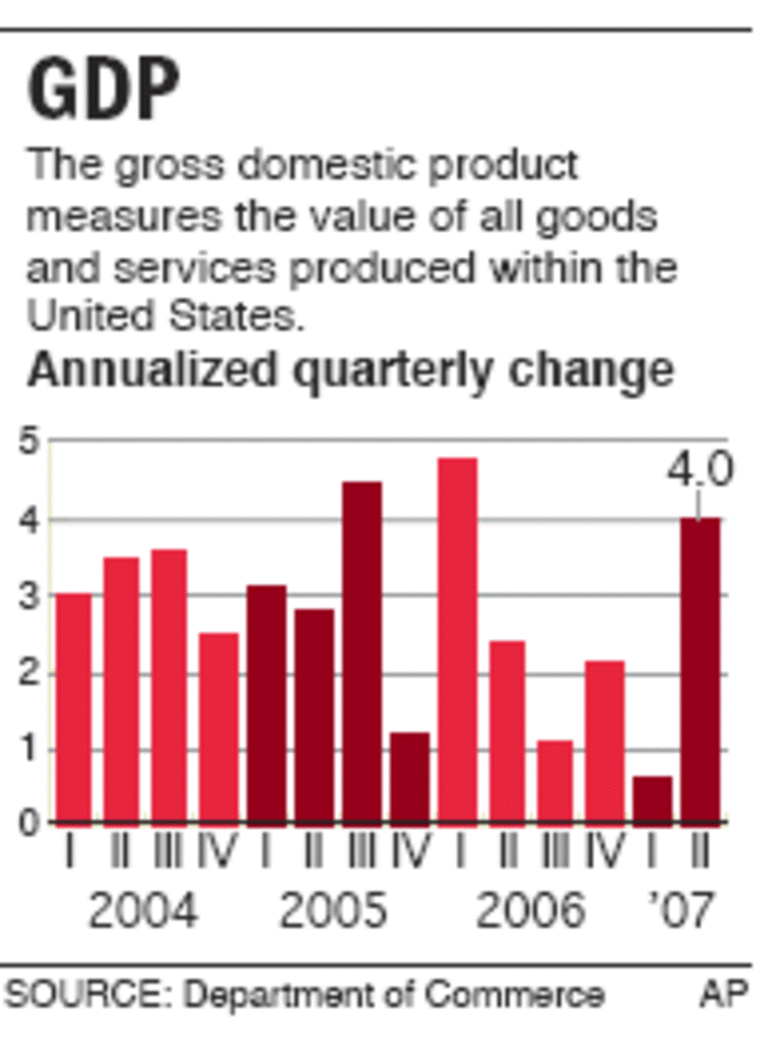The economy enjoyed a strong revival in the spring although growing troubles in housing and credit markets have darkened prospects considerably since then.
The gross domestic product, the broadest measure of economic health, expanded at an annual rate of 4 percent in the April-June quarter, the Commerce Department reported Thursday. That was the strongest showing in more than a year and considerably higher than the 3.4 estimate for growth made a month ago.
The improved performance reflected higher activity in such areas as international trade and business investment, which offset a continued plunge in housing construction.
But that growth could be the best showing for some time as the economy continues to be battered by the worst housing slump in 16 years and a widening credit crisis that has sent financial markets on a roller-coaster ride in recent weeks.
“The economy has taken a significant blow from the turmoil in financial markets and the housing downturn, which is intensifying,” said Mark Zandi, chief economist at Moody’s Economy.com.
Many economists said they expected growth to slow to around 2 percent in the current quarter, just half the spring pace, and perhaps dip below 2 percent in the final three months of this year as the impacts from the market turbulence on consumer and business confidence take more of a toll.
But analysts said they still believe the current economic expansion, which will be six years old in November, will be able to avoid a full-blown recession.

“While a recession in the United States is clearly possible, one of the biggest positives going forward is that the rest of the world still looks good, which means we will get continued help from rising exports,” said Nigel Gault, chief U.S. economist at Global Insight.
An improved trade performance, representing higher sales of American products overseas and lower imports, was the biggest factor contributing to the second quarter improvement, adding 1.4 percentage points to the 4 percent growth rate.
Analysts said they also had confidence the Federal Reserve would act in time to ward off a recession by cutting interest rates should current financial troubles intensify.
Federal Reserve Chairman Ben Bernanke triggered a big rally on Wall Street on Wednesday after a letter was released in which he repeated assurances that the Fed was ready to “act as needed” to help the economy. Bernanke is scheduled to deliver a speech on housing and monetary policy at a Fed conference in Wyoming on Friday when he may offer some hints about future Fed rate actions.
The Fed’s next meeting is Sept. 18 and many analysts are predicting the Fed will start cutting the federal funds rate at that time, delivering from two to four quarter-point reductions this year and early next year. The funds rate has been at 5.25 percent for more than a year.
Those cuts would make borrowing cheaper for consumers and businesses and also help to mitigate the payment shock facing 2 million mortgage holders as their adjustable rate mortgages reset in coming months.
Hopes for a rate cut were increased when the Fed, in a special statement on Aug. 17, aimed at calming financial markets, said the “downside risks to growth have increased appreciably,” indicating it was now more worried about weak growth than inflation.
The Fed is seen as having the leeway to cut interest rates because inflation is easing. A key GDP inflation gauge that excludes food and energy rose by just 2 percent in the second quarter, compared with a year ago. That was better than a year-over-year gain of 2.4 percent in the first quarter, although at 2 percent it is still at the upper end of the Fed’s 1 percent to 2 percent comfort zone.
During the recent market turmoil, the Fed has pumped billions of dollars into the banking system and encouraged banks to borrow directly from its discount window.
In a second report Thursday, the Labor Department said the number of Americans filing claims for unemployment benefits rose for a fifth consecutive week, increasing by 9,000 to 334,000 last week, the highest level since April.
Analysts said some of those gains probably came from rising layoffs in the mortgage industry, where many firms specializing in offering subprime loans have had to cut payrolls or shut down.
The 4 percent GDP growth rate for the second quarter marked a sharp jump from the anemic 0.6 percent pace turned in during the first three months of the year. It was the fastest GDP increase since a 4.8 percent growth rate in the first three months of 2006.
Since then, the economy had slowed sharply, reflecting a major drag from housing, which continued to contract in the second quarter, falling at an annual rate of 11.6 percent, the sixth consecutive quarterly decline for housing.
In addition to an improving trade picture, the faster growth in the second quarter reflected rebuilding of depleted business inventories and double-digit gains in business investment in offices, shopping centers and other nonresidential projects as well as big increases in purchases of equipment and software.
Consumer spending, which accounts for two-thirds of total economic activity, did show a marked slowdown in the second quarter, growing at an annual rate of 1.4 percent, less than half the first quarter increase. Analysts said recent drops in consumer confidence since the market turmoil could depress spending further in the months ahead.